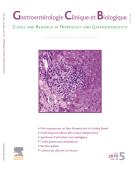Diagnosis of liver fibrosis using FibroScan and other noninvasive methods in patients with hemochromatosis: A prospective study - 23/04/08

Summary |
Background |
The role of hepatic iron overload in the development of hepatic fibrosis in patients with hemochromatosis is well-established. Transient elastography (FibroScan) is a new noninvasive, rapid, reproducible bedside method, allowing assessment of liver fibrosis by measuring liver rigidity.
Objectives |
The aim of this prospective study was to evaluate liver fibrosis with FibroScan and other noninvasive biochemical methods in patients with hemochromatosis (C282Y homozygosity) compared with control patients.
Patients and methods |
From January 2004 through October 2006, all consecutive patients with hemochromatosis were evaluated for liver fibrosis using noninvasive methods (FibroScan and biochemical markers). These patients were compared with patients who had chronic cytolysis and no fibrosis on liver biopsy.
Results |
One hundred and three consecutive patients (57 cases and 46 controls) were fully investigated. Median FibroScan values were similar in both groups, 5.20kPa versus 4.9kPa, respectively. No differences were observed between cases and controls for all biochemical markers. A strong correlation was observed between FibroScan and many biochemical markers, although ferritin levels did not correlate with FibroScan values. The prevalence of patients with FibroScan values greater than 7.1kPa (cut-off level for significant fibrosis) was 22.8% in patients with hemochromatosis and 0% in the controls (P<0.0001).
Conclusion |
FibroScan and biochemical markers could be reliable noninvasive methods for detecting liver fibrosis in patients with hemochromatosis. Such patients have high FibroScan values more often than do control patients. Further longitudinal and prospective studies are necessary to confirm these preliminary data.
Il testo completo di questo articolo è disponibile in PDF.Résumé |
Introduction |
Le rôle de la surcharge en fer dans l’apparition de la fibrose hépatique au cours de l’hémochromatose est bien connu. L’élastométrie impulsionnelle par FibroScan est une méthode non invasive, rapide, reproductible pour évaluer la fibrose hépatique en mesurant l’élasticité hépatique.
But |
Le but de cette étude prospective était d’évaluer la fibrose hépatique par FibroScan et marqueurs sériques au cours de l’hémochromatose génétique (mutation C282Y homozygote) par rapport à des témoins.
Malades et méthodes |
De janvier 2004 à octobre 2006, tous les malades consécutifs suivis pour hémochromatose ont été évalués par FibroScan et marqueurs sériques de fibrose. Ces malades ont été comparés à des malades ayant une cytolyse chronique sans fibrose à la ponction-biopsie hépatique.
Résultats |
Cent trois malades (57 cas et 46 témoins) ont été étudiés. La valeur médiane de FibroScan était identique dans les deux groupes, respectivement 5,20 kPa versus 4,9 kPa. Aucune différence significative n’a été mise en évidence entre les deux groupes pour tous les marqueurs sériques de fibrose. Une forte corrélation a été mise en évidence entre les valeurs de Fibroscan et des marqueurs sériques de fibrose mais le taux de ferritine n’était pas corrélé à la valeur de FibroScan. La prévalence des malades avec FibroScan était supérieure à 7,1 kPa (valeur seuil pour le diagnostic de fibrose significative) était de 22,8 % chez les patients avec hémochromatose et de 0 % chez les témoins (p<0,0001).
Conclusion |
Le FibroScan et les marqueurs sériques de fibrose sont de bonnes méthodes pour évaluer la fibrose hépatique au cours de l’hémochromatose. Les malades suivis pour hémochromatose ont des valeurs de FibroScan plus élevées que les témoins. D’autres études longitudinales et prospectives sont encore nécessaires pour confirmer ces résultats préliminaires.
Il testo completo di questo articolo è disponibile in PDF.Mappa
Vol 32 - N° 2
P. 180-187 - Febbraio 2008 Ritorno al numeroBenvenuto su EM|consulte, il riferimento dei professionisti della salute.

